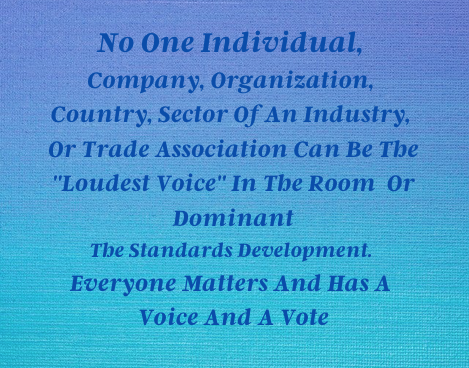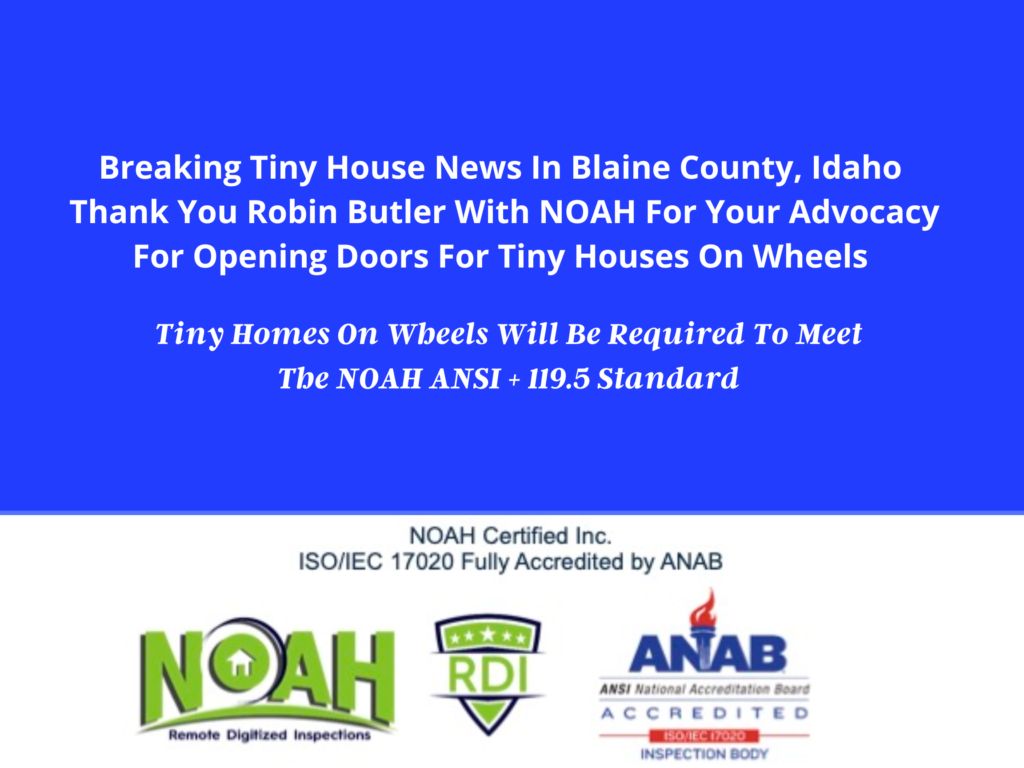Blaine County Ordinance NO. 2022-03
Robin Butler with NOAH just shared Blaine County, Idaho ordinance NO. 2022-03 with me that is breaking news for the tiny house industry. This is a county that clearly sees that tiny homes on wheels are a viable housing solution for attainable and affordable housing. County Commissioner Dick Fosbury is a champion for tiny houses and we appreciate his hard work on this endeavor and all the advocates involved.
Highlights Of The Bill
AN ORDINANCE OF BLAINE COUNTY, IDAHO, AMENDING TITLE 9, ZONING REGULATIONS, CHAPTER 2 – DEFINITIONS, AND CHAPTER 3, SECTION 11 – ACCESSORY DWELLING UNITS, TO PROVIDE FOR THE REGULATION OF TINY HOME ON WHEELS; PROVIDING A SEVERABILITY CLAUSE AND EFFECTIVE DATE.
WHEREAS the County wishes to regulate these units because
tiny homes on wheels do not meet building codes as dwelling units;

Photo Courtesy Mitchcraft Tiny Homes: Inspected By NOAH
DWELLING, ACCESSORY: A separate building or portion thereof or portion of a residential building excluding mobile homes and Tiny Home on Wheels which may, but is not required to, provide complete, independent living facilities for a household including permanent provisions
for living, sleeping, cooking, eating, and sanitation. The primary factors which cumulatively may result in a building or portion of a building being classified as an accessory dwelling unit are that:
- The area is not functionally integrated with the floor plan of the primary residence (i.e., the area does, it does not share a common hallway); it has a separate entrance and it can be locked off from the primary residence and used independently from the primary residence.
- There is a kitchen area consisting of a sink, counters, cabinets, refrigerator and cooking appliance; or electrical outlets and plumbing that would support kitchen facilities.
- There is a bathroom consisting of a toilet, sink and shower or bathtub or both
TINY HOME on WHEELS: a recreational vehicle unit that is between 150 and 400 square feet in size and that provides independent living facilities for one or more persons, which includes temporary provisions for living, sleeping, eating, cooking, and sanitation and has been certified to meet American National Standards Institute (ANSI) A119.5 Standards, National Organization of Alternative Housing (NOAH) ANSI+ Standards,and 9-3-11:Section D of this
ACCESSORY DWELLING UNIT(S) AND TINY HOME ON WHEELS: The purpose of the accessory dwelling unit and Tiny Home on Wheels regulations is to define an accessory dwelling unit and Tiny Home on Wheels; address under what circumstances it is appropriate to allow increased density on a lot; and address the impacts an accessory dwelling unit or Tiny Home on Wheels may have on the surrounding area such as sanitation, increased traffic and compatibility with the neighborhood.
A conditional use permit obtained from the commission or hearing examiner may be required for an accessory dwelling unit or Tiny Home on Wheels as required below in sections 9-3-11(A)(1), (A)(2) and (A)(4). Notice and hearing procedures contained in chapter 25 of this title shall be followed. The application shall be subject to the provisions contained herein and the standards of evaluation contained in subsections 9-25-3(A)(3) and (A)(4) of this title.
Tiny Home on Wheels shall be regulated in the same way as Accessory Dwelling Units and are subject to the standards herein except where specifically noted.
A. Standards: The following standards shall be met prior to issuance of a building permit for an accessory dwelling unit or a zoning review for a Tiny Home on Wheels:
- On lots of less than one acre in size and on an Idaho Department of Environmental Quality regulated community water system or municipal water system, where allowed by South Central Public Health District (a variance from South Central Public Health District may be required) and with a will-serve letter from the Certified Water Operator for the system, one accessory dwelling or one Tiny Home on Wheels unit may be allowed under a conditional use permit.
- On lots of one acre to less than two (2) acres in size, (where allowed by South Central Public Health District) (a variance from South Central Public Health District may be required), one accessory dwelling unit or one Tiny Home on Wheels may be allowed under a conditional use permit.
- On lots of two (2) acres to less than five (5) acres in size, one accessory dwelling unit or one Tiny Home on Wheels shall be a permitted use.
- On lots of five (5) acres or greater in size:
- One accessory dwelling unit or one Tiny Home on Wheels shall be a permitted use. b. A second accessory dwelling unit or second Tiny Home on Wheels may be allowed under a conditional use permit.
C. Restrictions: All Tiny Homes on Wheels:
- The proposed moveable Tiny Home on Wheels is licensed and registered with the Idaho Transportation Department Division of Motor Vehicles.
- The proposed moveable Tiny Home on Wheels has been certified by a third-party inspection agency ie: NOAH or other agency approved by Administrator as meeting ANSI A119.5 Standardsi, NOAH ANSI+ Standardsii and standards in Section D.
- The Tiny Home on Wheels shall be connected to the water and wastewater system serving the primary residence, as inspected by the South Central Public Health District (wastewater) and the State of Idaho Plumbing Program (potable water connection).
- Wheels may not be removed from the Tiny Home. Applicant/owner of the Tiny Home on Wheels shall be responsible for placement of the Tiny Home on Wheels per manufacturers specifications.
- No exterior additions such as porches, lean-tos or sheds are permitted, with the exception of factory-fabricated porches and decks lower than 18” in height.
6 Tiny Homes on Wheels shall comply with 9-3-11.B.2,3, 4, 6, 7, 8 and 9, and 9-3-11C. 1-6 to ensure standards are met. Zoning approval shall terminate in 5 years and may be renewed if the zoning standards at that time are met. If Tiny Homes on Wheels are removed from Blaine County Code as an allowable use, no structure shall be considered legally non-conforming.
D. ANSI + Standards: All Tiny Homes on Wheels
All Tiny Homes on Wheels are required to meet the ANSI A119.5 Standardsi, NOAH ANSI+ Standardsii and the following standards listed specific to Blaine County’s climatic conditions.
- Inspection Stages 1-5 of the most recent NOAH ANSI+ Standard Inspection Guidesii shall be certified complete and approved by NOAH and submitted to the Blaine County Zoning Department.
- Additional requirements based on Blaine County’s climatic conditions:
- Minimum insulation R-values: Walls R-19, floors R-20 and roof /ceiling R-28. Vaporretarders shall be in accordance with the International Residential Code.
- Windows and doors: Shall have a maximum .30 U-factor.
- Roof Snow Load: Shall meet the site specific requirements set forth in 7-1-3,(01), (M) d. Skirting- Insulated skirting is required
- Sunset Provision:
9-3-11 and 9-2 shall be effective from 5/17/2022 until 5/17/2027. It shall be null and void as of that date unless re-adopted by ordinance.
Blaine County Ordinance NO. 2022-03


NOAH Endorses Potential ASTM Standards
A Message From Robin Butler:Why ASTM?
Ever since Noah came into the tiny house industry in 2015, we have been using Standards and Codes that did not quite fit. Because of the wheels, the I Codes were passed over, and the RV standards (NFPA 1192 and ANSI 119.5) were what most builders, jurisdictions and industry proponents opted for. Appendix Q came into the 2018 IRC but again left out the wheels or movability of Tiny Homes. Since the majority of the tiny home owners were living full time in their home, the RV Standards seemed insufficient for items like structural and energy standards.
In addition the homes have tiny home unique issues. They very small, well insulated and with better windows and are subject to tiny home specific moisture issues. And since they potentially move more than once in their life time, they must be able to be “unplaced” and make trips across our highways.
The need for tiny home specific standards and codes are real. The effort to create a committee through ASTM has, in my opinion, has gotten the most traction and has the best potential for meeting these needs in a timely manner.
Advanced Technology to Inspect the World

